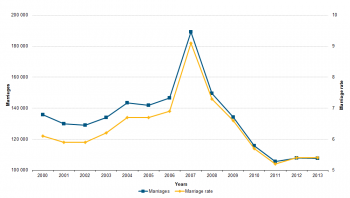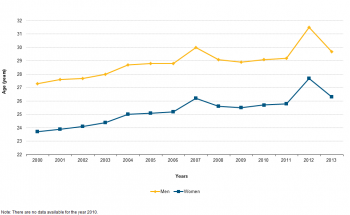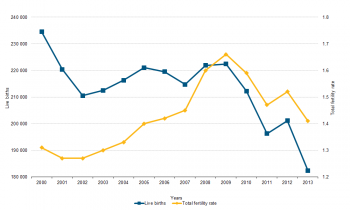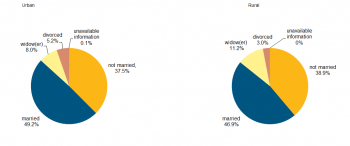Archive:Marriages and births in Romania
Romania between modernism and traditionalism
- Author: Radu Baetica, National Statistical Office of Romania.
- Data extracted in June 2015.
This article on marriages and births is part of a pilot project implemented by Eurostat together with eight Member States (Estonia, Spain, Latvia, Croatia, the Netherlands, Romania, Slovenia and Sweden). The aim of the pilot project is to better reply to user's needs by complementing the Eurostat article presenting data on an EU level with more detailed information on the same topic, but at national level. Articles from the eight Member States are available in the corresponding national languages as well as in English and they form, together with the Eurostat article, an online publication.
In Romania, on the one hand, family continues to be an essential element in the life of the individual, with official marriage still being a way to start a family and consensual union not being as widespread as in other Member States (the share of persons who were living in a consensual union at the reference time of the census remained practically unchanged from the 2002 census to the 2011 census). On the other hand, people are getting married at older ages, after the education process is completed, when they are integrated in the labour market and have the material resources necessary for a decent living standard as a couple. The increase in the average age at first marriage leads to an increase in the age at which mothers decide to have a child and implicitly to a reduction of the number of years in which the birth of additional children is possible, with negative effects on the short-term fertility index.
More and more children are being born out of marriage, which means that this decision no longer depends as much on the status of married person, on the opinion or disapproval of other people, but is mainly determined by other criteria: finding a suitable life partner, receiving an adequate income, having the material resources necessary for properly raising and educating children, special circumstances in the life of every individual, etc.
Main statistical findings
Legal marital status
According to the final results of the 2011 Population and Housing Census, over half of Romania’s resident population[1] aged 20 years and over consisted of married persons (61.1%), and one person out of five had never been married (21.5%). Widows and widowers accounted for 12.0% of the population aged 20 and over, and divorced persons for 5.4 %.
716.4 thousand persons, accounting for 4.5 % of the population aged 20 and over, declared that they were living in a consensual union. Approximately three quarters of them had never been legally married, and 17.3 % were divorced persons at the reference time of the census.
Marriage rate
107 507 marriages were recorded in Romania in 2013; the downward trend that had started in 2007 continued. After a slight decline in the 2000-2002 period, the number of marriages in Romania experienced an upward trend until 2007, when marriages in Romania reached a maximum level due to the implementation of legislation that granted financial support to couples who married for the first time (Law No 396/2006).
The evolution of the marriage rate followed that of the absolute number of marriages, ranging from a minimum of 5.2 marriages per 1 000 inhabitants in 2011 to a maximum of 9.1 ‰ in 2007.
The analysis of the average age at the first marriage shows that this age has steadily increased and that there is a constant trend of postponing marriage. In 2007 (the first year after the implementation of the financial support), a slight increase in this age was reported due to those marriages that had been postponed for financial reasons. The trend of the marriage rate closely follows that of the number of marriages, with a maximum (8.8 marriages per 1 000 inhabitants) recorded in 2007, after which the marriage rate dropped considerably as a result of the external migration triggered by Romania’s EU accession and the opening of borders.
Divorce rate
28 507 divorces were pronounced by final sentence or decision of a notary public or a civil register officer in 2013, with a divorce rate of 1.4 divorces per 1 000 inhabitants. The number of divorces and the divorce rate dropped compared to the 2000-2012 period, after an unsteady evolution with an upward trend in the 2004-2011 period.
Birth rate
The smallest number of live births in Romania ever since 2000 was recorded in 2013: 182 313. After a marked decline in the first three years of the reference period, the birth rate experienced a slight rise in the 2003-2009 period due in part to the support granted to persons who married for the first time by a 2006 law. A constant upward trend of the total fertility rate[1] started in 2002 and reached a maximum of 1.66 children per woman in 2009, after which the total fertility rate experienced a marked decline until 2013, a year in which a level close to that of the 2005-2006 period (when the birth rate was approximately 20 % higher than in 2013) was reported.
National characteristics
A characteristic of marriages in Romania is the seasonality. Marriage, a civil act, is strongly influenced by religious observance. The graph below shows the seasonality of marriages, with a March-April minimum counterbalanced by a peak in the summer months, particularly in August. One can also see the influence of Law No 396/2006 granting financial support to couples who married for the first time, both in the first year after the adoption of the law (2007) as well as in the year that followed (a peak of marriages in August 2008, the favourite month for getting married). The repeal of the above-mentioned law[2] in 2010 led to a rapid decrease in the number of marriages in Romania.
Consensual unions and marriages between persons of the same sex are not legally recognised in Romania. A civil code reform that introduced the possibility of divorce by administrative process was adopted in Romania in 2010, which involved using a much simplified procedure. This led to an increase in the number of divorces in 2011, an increase which, as in the case of marriages, was based on couples who had postponed divorce; subsequently, the number of divorces started to drop. One can see differences in the legal marital status of the resident population depending on the residence area. Thus, the share of married persons is close to 50 % in the urban area, while this share is only 46.9 % in the rural area. There are more divorced persons in the urban area than in the rural area.
There are more widows and widowers in the rural area (11.2% of the total rural resident population compared to 8.0% in the urban area). The demographic events in Romania in the last 15 years, which have been influenced by numerous economic and social factors, bear the mark of both traditionalism and modernism.
Context
Vital events also generate deep changes in the social structure, with significant implications at the level of state budgets, the pension scheme and public policies. The study of the marriage rate is particularly important in demography, as the marriage rate is a significant contributing factor to the birth rate. Marriage is a natural act in the evolution of society and usually leads to children, which means an increase in the population. The information on the birth rate is vitally important because the birth rate directly influences the size of the natural increase and hence the demographic developments and changes in Romania, with considerable implications on demographic ageing. These vital events have a decisive influence on social policies, particularly on labour market, health care and education policies.
See also
Other information
Notes
[[Category:<Statistical article>|Marriages and births in Romania]] [[Category:<Population>|Marriages and births in Romania]] [[Category:<Marriages and divorces>|Marriages and births in Romania]]






